View in other NatureServe Network Field Guides
NatureServe
Montana
Utah
Wyoming
Idaho
Wisconsin
British Columbia
South Carolina
Yukon
California
New York
Herbaceous Greenbrier - Smilax lasioneura
Other Names:
Smilax herbacea
Native Species
Global Rank:
G5
State Rank:
S4
(see State Rank Reason below)
C-value:
8
Agency Status
USFWS:
USFS:
BLM:
External Links
State Rank Reason (see State Rank above)
Smilax lasioneura occurs in eastern Montana where it grows in woodlands, riparian forests, and thickets. Populations appear stable, can be common in certain areas, and few threats have been identified. However, current data on population locations, sizes, and threats is needed.
- Details on Status Ranking and Review
Range Extent
ScoreF - 20,000-200,000 sq km (~8,000-80,000 sq mi)
Area of Occupancy
ScoreE - 26-125 4-km2 grid cells
Number of Populations
ScoreC - 21 - 80
Number of Occurrences or Percent Area with Good Viability / Ecological Integrity
ScoreC - Few (4-12) occurrences with excellent or good viability or ecological integrity
Environmental Specificity
ScoreC - Moderate. Generalist or community with some key requirements scarce
Threats
ScoreD - Low
General Description
PLANTS: Herbaceous annuals that grow as erect to ascending vines (Lesica et al. 2012; FNA 2014). Stems 30–120 cm. Tendrils from the leaf axils.
LEAVES: Simple, petiolate, alternate. Petioles are shorter than the blade (FNA 2014). Leaf blades are ovate, cordate to truncate, 5–9 cm long, net-veined, puberulent beneath, and pale green beneath (Lesica et al. 2012).
INFLORESCENCE: Axillary umbels with numerous flowers; peduncles 3–8 cm. Flowers unisexual, star-shaped, green; tepals 6, separate, spreading, oblong, 3–4 mm long; stamens 6, shorter than the tepals, reduced in female flowers; ovary 3-celled, superior; stigmas 3. Fruit a 3- or 6-seeded, blue berry 6–10 mm long (Lesica et al. 2012).
Our plants are variety lasioneura (Hook.) A. DC.
Phenology
Flowering May through June (FNA 2014).
Species Range
Montana Range
Range Descriptions
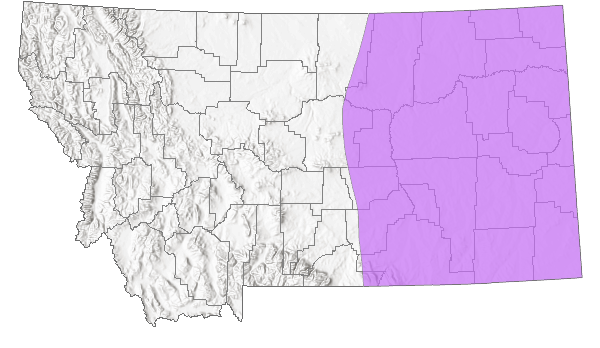
 Native
Native
Range Comments
SK to ON south to WY, TX, MS and FL (Lesica et al. 2012. Manual of Montana Vascular Plants. BRIT Press. Fort Worth, TX).
Observations in Montana Natural Heritage Program Database
Number of Observations: 52
(Click on the following maps and charts to see full sized version)
Map Help and Descriptions
Relative Density
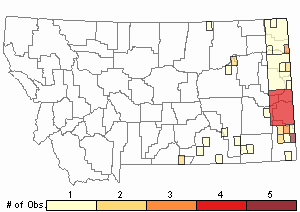
Recency
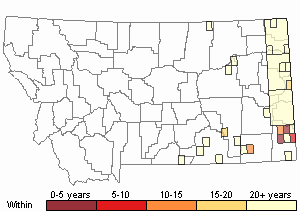
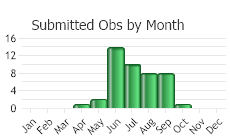

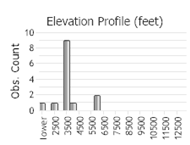 (Observations spanning multiple months or years are excluded from time charts)
(Observations spanning multiple months or years are excluded from time charts)
Habitat
Ecology
Plants growing in southern humid areas tend to be larger than those from northern areas (FNA 2014).
Stewardship Responsibility
References
- Literature Cited AboveLegend:
 View Online Publication
View Online Publication Flora of North America Editorial Committee. 2002. Flora of North America North of Mexico. Vol. 26. Magnoliophyta: Liliidae: Liliales and Orchidales. New York, NY: Oxford Univ. Press. xxvi + 723 pp.
Flora of North America Editorial Committee. 2002. Flora of North America North of Mexico. Vol. 26. Magnoliophyta: Liliidae: Liliales and Orchidales. New York, NY: Oxford Univ. Press. xxvi + 723 pp. Lesica, P., M.T. Lavin, and P.F. Stickney. 2012. Manual of Montana Vascular Plants. Fort Worth, TX: BRIT Press. viii + 771 p.
Lesica, P., M.T. Lavin, and P.F. Stickney. 2012. Manual of Montana Vascular Plants. Fort Worth, TX: BRIT Press. viii + 771 p.
- Additional ReferencesLegend:
 View Online Publication
View Online Publication
Do you know of a citation we're missing? Boggs, K. W. 1984. Succession in riparian communities of the lower Yellowstone River, Montana. M.S. Thesis. Montana State University, Bozeman, 107 pp.
Boggs, K. W. 1984. Succession in riparian communities of the lower Yellowstone River, Montana. M.S. Thesis. Montana State University, Bozeman, 107 pp. DuBois, K.L. 1979. An inventory of the avifauna in the Long Pines of Southeastern Montana. M.Sc. Thesis. Bozeman, MT: Montana State University. 113 p.
DuBois, K.L. 1979. An inventory of the avifauna in the Long Pines of Southeastern Montana. M.Sc. Thesis. Bozeman, MT: Montana State University. 113 p. Lesica, P., M.T. Lavin, and P.F. Stickney. 2022. Manual of Montana Vascular Plants, Second Edition. Fort Worth, TX: BRIT Press. viii + 779 p.
Lesica, P., M.T. Lavin, and P.F. Stickney. 2022. Manual of Montana Vascular Plants, Second Edition. Fort Worth, TX: BRIT Press. viii + 779 p.
- Web Search Engines for Articles on "Herbaceous Greenbrier"





